Bulleted lists enhance readability by breaking down key skills and accomplishments into concise, easily scannable points, allowing recruiters to quickly grasp essential qualifications. Narrative descriptions provide context and storytelling, showcasing achievements with depth and demonstrating the impact of specific roles. Combining both formats strategically can create a balanced resume that highlights critical details while maintaining engaging, comprehensive content.
Table of Comparison
| Feature | Bulleted Lists | Narrative Descriptions |
|---|---|---|
| Readability | High - Quick scanning with clear points | Moderate - Requires more attention to read fully |
| Conciseness | Excellent - Brief, direct statements | Often Lengthy - More detailed explanations |
| Impact | Strong - Highlights key achievements | Moderate - Provides context and storytelling |
| SEO and Keyword Optimization | Highly effective - Easier integration of keywords | Effective - Allows natural keyword usage |
| Applicant Tracking Systems (ATS) | ATS-friendly - Structured data improves parsing | Riskier - Longer text may reduce keyword density |
| Use Case | Best for technical skills, achievements, and quick facts | Best for storytelling, elaborating roles and responsibilities |
Introduction to Resume Content Formats
Bulleted lists in resumes enhance readability by highlighting key skills, achievements, and responsibilities in concise, easy-to-scan points. Narrative descriptions provide context and demonstrate storytelling ability, showcasing accomplishments with detailed examples. Combining both formats strategically improves content clarity and engagement, aligning with applicant tracking system (ATS) optimization and recruiter preferences.
What Are Bulleted Lists?
Bulleted lists in resume writing are concise, easy-to-read points that highlight key skills, achievements, and responsibilities. They improve scanability, allowing hiring managers to quickly grasp essential information. Using bulleted lists emphasizes specific accomplishments and measurable results, making your resume more impactful.
Understanding Narrative Descriptions
Narrative descriptions in resume writing provide context and showcase achievements through detailed storytelling, allowing candidates to highlight problem-solving skills and project outcomes effectively. Unlike bulleted lists, narratives enable the integration of metrics and qualitative impact, creating a stronger emotional connection with potential employers. Crafting clear and concise narratives enhances the resume's persuasiveness, making skills and experiences more memorable to hiring managers.
Key Benefits of Using Bulleted Lists
Bulleted lists enhance resume readability by breaking down complex information into easily digestible points, making key skills and achievements stand out. They improve scan-ability for recruiters who often spend seconds reviewing each resume, increasing the chances of important qualifications being noticed quickly. Bulleted lists also allow succinct presentation of accomplishments, highlighting measurable results and specific contributions effectively.
Advantages of Narrative Descriptions
Narrative descriptions in resumes provide a comprehensive explanation of job roles, showcasing achievements with context and highlighting problem-solving skills that bulleted lists often overlook. This format allows candidates to demonstrate their communication abilities and create a compelling story that captures the employer's attention. Employers benefit from understanding the candidate's impact in previous roles through detailed, flowing narratives that connect skills and experiences effectively.
When to Use Bulleted Lists in a Resume
Bulleted lists in a resume effectively highlight key skills, accomplishments, and job responsibilities, making information easily scannable for recruiters. Use bulleted lists when showcasing quantifiable achievements, technical proficiencies, or specific tasks that demonstrate expertise and impact. This format enhances readability and ensures important details stand out quickly during applicant screenings.
Ideal Scenarios for Narrative Descriptions
Narrative descriptions are ideal for roles requiring storytelling or when explaining complex projects and achievements that highlight problem-solving skills. They effectively convey context, motivations, and outcomes, making them suitable for creative positions, leadership roles, or fields where interpersonal skills are crucial. This format allows for a deeper connection with hiring managers by illustrating impact and thought processes beyond simple task listing.
Impact on ATS and Recruiters
Bulleted lists enhance ATS compatibility by clearly separating skills and achievements, making keywords more accessible for algorithmic parsing. Recruiters prefer bulleted formats as they allow quick scanning of key qualifications, improving readability and candidate evaluation speed. Narrative descriptions may enrich context but risk diluting critical keywords, potentially hindering ATS optimization and recruiter efficiency.
Hybrid Approaches: Combining Both Styles
Hybrid approaches in resume writing merge bulleted lists and narrative descriptions to enhance clarity and depth. Bulleted lists efficiently highlight key achievements and skills, while narrative descriptions provide context and storytelling to demonstrate impact. This combination improves readability and engagement, increasing the chances of capturing recruiters' attention in competitive job markets.
Tips for Choosing the Right Format
Bulleted lists enhance readability by highlighting key achievements and skills, making it easier for recruiters to scan important information quickly. Narrative descriptions provide context and demonstrate the impact of your experiences through detailed storytelling, ideal for roles requiring strong communication skills. Choose bulleted lists for clarity and efficiency in technical fields, while narratives work best in creative or managerial positions to showcase depth and problem-solving abilities.
Bulleted lists vs narrative descriptions Infographic

 bizdif.com
bizdif.com